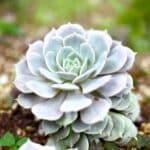If you are a gardener, then you’ve probably heard about Anthurium Crystallinum and Anthurium Clarinervium. Both plants are among the most popular houseplants and will add beauty, attraction, and amazing looks to your indoor décor.
Sometimes, you might mistake one for the other, as they have an almost similar appearance and features. However, they possess few differences. But what is the difference between Anthurium Crystallinum vs Clarinervium?
The clarinervium features broader dark green, heart-shaped leaves with slower growth, whereas the crystallinum features narrower, elongated light green leaves and faster growth.
This article takes a closer and deeper look at these houseplants, highlighting their main differences and similarities.
Let’s get started!
Table of Contents
What is Anthurium Crystallinum?
Also known as the Crystal Anthurium plant, the anthurium crystallinum is a Panamanian plant with a tropical-looking feel. It is an epiphytic plant type and perennial.
It is called crystallinum because it has interesting features like gorgeous, enormous, oval-shaped, velvety, and highly veined foliage.
It can grow over 90cm tall and is mostly cultivated in tropical gardens, yet widely considered an indoor plant or sensitive patio plant in temperate weather conditions worldwide.
As earlier discussed, it is one of the most popular houseplants, and unlike most others, it is mostly cultivated for its foliage and not its flowers.
Owing to its frost fragility nature, it is ideal indoors, where you’ll place it in a location that is partially sheltered and provided with well-drained soil to enhance perfect growth.
Meanwhile, it is one of the easiest plants to maintain. Its leaves are dark green and sometimes tinted with red-purple and obvious white veins and greenish-yellow inflorescences, and so on.
What is Anthurium Clarinervium?
Unlike crystallinum, the anthurium clarinervium is a Mexican perennial plant. It comes from the Araceae family and is predominantly seen growing in rocky locations with shady limestone outcroppings or karst.
It is epiphytic, which means that it mostly grows on top of other plants or tree trunks; hence, called a lithophyte or epipetric plant.
Because its natural origin is southern Mexico, the clarinervium is used to a warmer climate, even though it is a plant that can adapt easily and quickly to colder conditions. It features enormous, broad, oval dark-green leaves and white veins that look like the spades symbol in-game cards.
In other words, it is a plant with heart-shaped leaves that features gorgeous dim green, gold, or silver-colored concentric veins, and underneath the leaf is generally light green.
It stays more compact when growing compared to its leave sizes. It has a strong root that provides stability in shallow soil squeezed between stones.
Generally, the clarinervium stems can grow as high as 15 to 20ft, while the leaves can grow up to 8 to 10ft. Though it is not as big as other varieties, it is ideal as a houseplant, as well as makes it less difficult to care for or maintain.
Anthurium Crystallinum Vs Clarinervium
| Anthurium Crystallinum | Anthurium Clarinervium |
| Has slender leaves | Has more robust leaves |
| Has a more complex silver rein pattern | Has a lesser complex silver rein pattern |
| Features more elongated heart-shaped leaves | Features more straightforward heart-shaped leaves |
| Features brighter leaves | Features darker leaves |
| Has a faster growth rate | Has a slower growth rate |
| Berries begin with white and end with purple color with maturity | Berries begin with white color and end with orange color as they mature |
| Smaller berries with a single seed | Bigger berries with many seeds |
| Can grow up to 30ft tall & 15ft wide | Can grow up to 25ft tall & 15ft wide |
Differences Between Anthurium Crystallinum and Anthurium Clarinervium

As we earlier stated, without a closer look, you will be confusing both anthurium varieties to be the same plant because of their identical appearance and traits. However, there are notable differences between them, but the most obvious of them all can be found in their leaves.
For instance, the anthurium crystallinum possesses more slender leaves, making them easily susceptible to damage, as opposed to anthurium clarinervium, which possesses thicker and leathery leaves that make them more robust.
The crystallinum has a more complex silver rein pattern than the clarinervium.
Still, on the leaves, both species feature heart-shaped leaves. However, that of the clarinervium is more obvious than its opposite variety, which leaves are more elongated.
The crystallinum has brighter leaves than that of clarinervium, which is darker. Therefore, you can see the patterns on the crystallinum more than that of the clarinervium.
In terms of growth rate, the anthurium crystallinum grows faster than the anthurium clarinervium, especially when offered the same conditions. The former also has more buds and aerial roots than the latter, thereby making it a little denser and adding up at a faster rate.
There are also differences in their berries. For instance, the crystallinum begins with white berries, and as they mature, they change into purple.
On the other hand, the clarinervium berries begin with white also, but as they mature, they become orange in color. The berries of the latter are bigger because of their numerous seeds, unlike the former that has just one seed.
Another notable difference between the two is their reproduction process. For instance, the clarinervium produces flowers and more seeds more often than the crystallinum; hence, its stunted growth and flowers are also larger.
Also, the crystallinum reproduces through vegetation, whereas the clarinervium reproduces generationally.
Is Anthurium Crystallinum Similar to Clarinervium?
Despite the notable differences, the anthurium crystallinum and clarinervium share some common features. For instance, both require feeding during the growing season and do not need excessive fertilizing to avoid stunted growth. Also, the fertilizer must contain a higher amount of phosphorus, nitrogen, and potassium.
Like most other anthurium varieties, both the crystallinum and clarinervium cannot thrive in the dry air; therefore, their humidity should be at the optimum level, not lower than 55 to 65%. Rather than decrease their humidity level, keeping it as high as 75 to 85 percent is best.
As long as the lighting needs are concerned, both plants do best in bright and indirect sunlight. Their tropical origins grow under huge trees where they get filtered sunlight; therefore, it is quite important to maintain a balance in their lighting.
Again, both plants also share the same temperature needs, as they require higher temperatures during spring or summer seasons but not during the winter season. Their temperatures shouldn’t be less than 55 degrees F. anything below that could lead to the death of the plant, be it crystallinum or clarinervium.
Both the crystallinum and the clarinervium share similar soil needs, as they both do best in well-drained soil. They also require loose soil, as thick clay can be disastrous to the plant or cause root rot.
They both grow in partially acidic soil ranging from 3.5 to 6.8 and require the same potting mix of 50% sphagnum, 25% perlite, and 25% bark.
Another common feature of both plants is in their water requirements. In other words, both varieties need more water both during the summer and spring and should be done at least thrice a week and when the soil is 25% dry. Overwatering can result in root rot.
Related Posts:
- Alocasia Maharani Care
- Philodendron Bipinnatifidum Vs Selloum
- Anthurium Vittarifolium Care
- Philodendron Shangri La Care
- Hoya Australis Care




